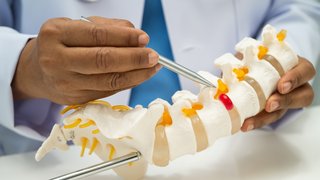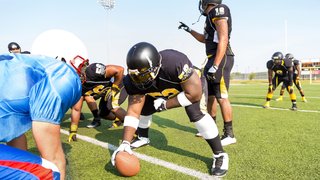Pickleball injuries increasing along with sport's popularity
December 26, 2023

Pickleball, America’s fastest-growing sport, is designed to be low-impact, inclusive, and easy to learn. A hybrid of tennis and pingpong, the game invented by three dads trying to keep their kids busy over the summer also results in far fewer injuries than other racquet sports.
Most of the action in pickleball happens at or below shoulder level and relies on controlled movements, making it a relatively safe exercise option for people with chronic shoulder or low-back pain. The pickleball court is also smaller than a tennis court, which means players get aerobic exercise without having to sprint or run at full speed.
Of course, no sport is risk-free, and we have seen a rise in pickleball-related injuries at the UT Southwestern Department of Orthopaedic Surgery. So, before you start dinking and diving, let’s consider some of the most common areas where pickleball injuries occur and discuss prevention strategies to keep you in the game.
Common aches and pains
Anybody who has played sports knows that when the competitive juices start to flow it can be easy to forget about safety, lose your balance, or stretch beyond your limits.
That holds true in pickleball, too. If you're not used to intense exercise and feel a strain diving or reaching for a shot, stop and try to assess your injury. Seek medical care if you:
- Feel sharp or shooting pain.
- Hear something pop in a joint or limb.
- Cannot move or bear weight on a joint or limb.
- Develop significant swelling or bruising that gets worse the next day.
While pickleball is generally considered low-impact and safe, these are some reported injuries associated with the sport.
Fall-related trauma
A study of over 200 picklers published in 2023 showed that 41.2% of reported injuries were caused by falling or diving for a shot, compared with just 30% from active game injuries and 5.4% from overuse.
During a fall, you may subconsciously throw out your hands to brace yourself. Unfortunately, that could put you at risk for a broken wrist or forearm. Broken elbows or shoulder bones can also happen in a fall, as can an AC (acromioclavicular) joint injury, or separated shoulder, and fractures associated with a previously replaced hip or knee.
We have seen several picklers in recent years with fall-related upper extremity fractures that require surgery. More picklers over 65 need surgery for wrist fractures than peers in the general population, likely due to age-related loss of bone density and muscle mass.
While falls can happen from tripping, we frequently see them in sports when players get aggressive and dive to return shots. Try to remember that you’re playing for fun, not a trip to the emergency department.
One of our patients told us after getting injured on the court that he had concluded “no ball is worth the fall.” That’s an excellent rule of thumb for pickleball, which is played on hard surfaces such as asphalt or concrete.
More articles from our Sports Medicine Team
-
Biceps tendonitis: How arthroscopic surgery relieves shoulder pain, reduces scarring
- Alison Cabrera, M.D.
March 24, 2022
Sore arms and hands
Pickleball may be easier on the shoulders than most other racquet sports, but it's not uncommon to see injuries to players’ hands, wrists, and elbows and the ligaments, tendons, and muscles in between. Most often we treat overuse injuries, which is when the tissues become inflamed due to repetitive movement, such as swinging a pickleball paddle. The paddle is usually made of composite plastic and only weighs 7-9 ounces, so it’s easy to overdo it when whipping the paddle at the whiffle ball.
According to a study published in Injury Epidemiology, the leading pickleball injuries among patients over 60 were strains, sprains, fractures, and bruising. The same study found that senior men were more than three times as likely to develop a sprain or strain, and women were over three times as likely to break a bone.
Data from a study published in Cureus found that epicondylitis (swollen tendons) and wrist fracture were the top two identifiable upper extremity injuries associated with pickleball. Swollen tendons usually can be treated with rest, ice, and anti-inflammatory medication. But many seniors with wrist fractures need surgery to place a plate in the wrist to mend the break.
Sprains, strains, and tears
Pickleball requires a lot of quick movements. Cutting, planting, and side-to-side steps can put players at risk for a sprained ankle or knee. Low-back discomfort is common among picklers, too, from pounding on the hard surface or wearing uncomfortable shoes.
As more people have continued to pick up pickleball, we’ve started to see more serious, longer-term injuries, such as:
- Torn MCLs or ACLs in the knee.
- Achilles tendinitis or tears in the ankle.
- Plantar fasciitis, or inflammation of the tissue band that runs from the toes to the heel.
- Strains or tears of the adductor magnus, the inner thigh groin tendon.
About 80% of patients with minor injuries can manage the pain with nonsurgical treatments, such as rest, ice, splinting, steroid injections to reduce inflammation, and physical therapy. Another option is regenerative medicine, such as platelet-rich plasma injections, shockwave therapy, or lipogems – injections of your own fat into injured tissue to promote healing.
Depending on the severity of the injury and your activity level, you may need surgery for severely strained or torn ligaments and tendons in the legs or ankles. There are many options to either replace or repair damaged tissues based on your future exercise goals.
Related reading: UCL injuries on the rise, from Little League to the major leagues
Tips to avoid pickleball injuries
Preventing new injuries usually starts with managing old ones. Some pickleball movements can exacerbate underlying conditions, such as:
- Arthritis: Work with your doctor to manage arthritis pain and get it to a tolerable place prior to swinging the paddle.
- Past soft-tissue injuries: If you tore your ACL or pulled a hamstring in your glory days, you probably already know how to ease into new activities to avoid reinjury.
- Balance: Practice side shuffles, cross-steps, and slowly walking backward, as well as doing stationary strength exercises, such as yoga or tai chi, to improve balance on the court.
Play within your means. If you haven’t been working out regularly, ease into the sport. Avoid diving for challenging shots. As your fitness increases, so will your ability to return more balls with less risk of injury.
Warm up. Start with light cardiovascular exercise, such as marching or jogging in place. Then do some active stretches. AARP recommends reverse lunges, squats, chest openers, trunk rotations, and even swim strokes. Pickleball University suggests doing backstepping drills, where you take one step backward every time you hit the ball across the net during warmups. Remember to cool down with a few minutes of light cardio and stretching after the game.
Dink around. Dinking refers to taking shots close to the net with a soft touch, making the ball land just over the net. Use these strategy shots to warm up your wrists, improve your footwork, and get your mind focused to play.
Choose the right shoes. Wear athletic court shoes that provide stability for side-to-side movements and cushioning for playing on the hard court.
Mix up your routine. Including other activities in your workout will help develop muscles beyond the ones you use for pickleball. Shaking things up can help you avoid overuse injuries.
Pickleball is designed to be fun, social, and easy to play, which is probably why it continues to grow in popularity. Don’t be afraid to give it a try and reap the exercise benefits – just make sure to warm up and play safely.
If you do get injured, please don’t hesitate to call one of our sports medicine or orthopaedic specialists at 214-645-8300 or request an appointment online. We’ll help you manage your injury and get back in the game.














